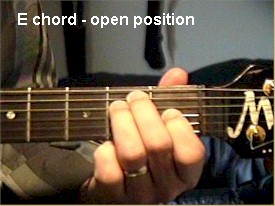Scroll through the lesson and click on notation/video/audio links to load the interactive players.
Please subscribe to get full access to all lessons for only $7.95/month PLUS 1 week free trial.

Riff Interactive lessons are
LESS expensive and
MORE interactive than alternatives!
More Info
|
|

Beginning Guitar I
- Lesson 4
Playing a Melody
Lyle: Last
lesson you learned real basic 1 finger chords and you jammed to a band as you
followed a chord progression. In this lesson I want to show you how to strum a
real big chord, and also play a melody from a scale. First learn this chord
called E:
E chord
- open position
E chord - open
position

Lyle: This is the lowest and heaviest sounding chords you
can play on the guitar. It uses all 6 strings. Use your 1st, 2nd, and 3rd
fingers for this chord. Can you get all 6 strings to ring clearly? Push down
firmly and make sure your fingers are out of the way of the surrounding
strings.
Lyle: Now strum this chord to a beat. Strum down on the
first and third beat of this jam track:
counting beats
counting
beats

Lyle: Here's a video clip to help show
you:
strumming the
E chord
Michelle: I'm
thinking I'm not going to be able to pull this one off unless I cut my
nails?
Lyle: Yes, long finger nails always get in the way of
pressing down on the strings. You're going to have to cut them on your fretting
hand.
Lyle: This E chord is a major chord, not a minor chord.
It is also called an "open position" chord because it's played on the lower
frets and there are open strings
involved.
wing5wong: So that's what open chord
means...?
Lyle: Yes. I plan on teaching you all about the open
chords and the bar chords in future lessons.... stay
tuned....
Lyle: Now let's learn a melody from a simple major scale.
This is the E major scale on the first string. Learn this scale forwards and
backwards on this single string:
E major scale
Lyle: Now for fun, play the scale along to this jam
track:
Jam Track
in E
Lyle: Here's a video example. Notice I play the scale
real smooth and to the beat, and I also descend the
scale:
E major
scale
Lyle: You can also strum the open position E chord along
to the jam track. Now you have two things you can do with the looping jam track,
1. strum the open E chord, 2. play the E major scale with
it.
Lyle: Now let's learn a simple melody that is made from
the notes in that scale. Try this piece of the melody:
melody -
part 1
Lyle: You can have the TAB file loop so you can play
along with it. You can also slow it down if that helps you. The suggested
fingerings will playback on the virtual fretboard. Here's a video clip of me
playing this melody. Notice I'm using all down strokes of the
pick:
melody -
part 1
Lyle: This is a melody from a very popular song around my
house.
Lyle: Here's the second part of the
melody:
melody -
part 2
melody - part
2
Lyle: The nice things about simple songs is that some
parts always repeat themselves throughout the song. This makes learning songs
quick and easy once you know what to look out for, the repeating sections.
Melody - part 3 is a repeat of part 1, but it has a different ending to
it:
melody - part
3
melody - part
3
Lyle: The 4th and final melody section of this mega hit
song is:
melody -
part 4
melody - part
4
Lyle: Here's what all 4 melody parts
look and sound like when put all together. Your goal is to play this right along
with me or the jam track.
melody - all 4 parts
melody - all 4
parts
Alkatrrrs:
What do the numbers on top of the regular notes
mean?
Support: They are just bar number in case the
teacher wants you to refer to one.
Lyle: If you have an electric guitar, you have
reach to higher frets. You could play this whole melody "an octave higher" by
moving it all 12 frets higher. Here's what it would be 1 octave/12 frets higher.
I've also added some overdrive effects to my guitar to give it a different
sound:
melody - 1
octave higher
melody - 1
octave higher
Lyle:
On all of this lesson, the chord, the scale, and the melody, use a down stroke
with your pick.
Lyle: It's very important to practice playing
along to the jam track so you'll get good at staying right with the
beat.
Lyle: Be sure to practice hard and make this
lesson sound good! Practice strumming the chord to the jam track, practice the
scale up and down the neck along to the jam track, and be able to play the
melody to the jam track. This all takes time to memorize and get your fingers
trained so go easy on yourself if you don't get it all right away. Just keep
playing, just keep playing....
Lyle: Let's take a break for now. Let me know if
you have a question about this lesson or you might like to get your own custom
private lesson to help you become a better guitarist. Email me at Lyle@theguitar.net. I can even teach you
your favorite songs in a lesson like this and you can download them too. Thanks,
Lyle
|
<< load notation from left
|
|
<< load audio from left
|
<< load audio from left
|